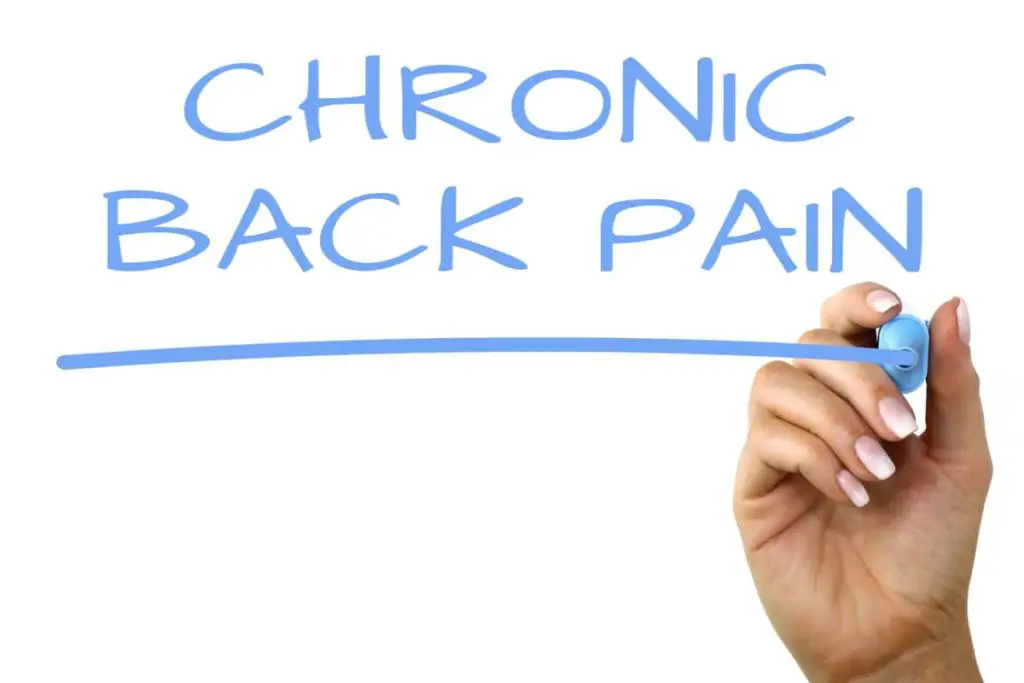If you’re like me, you’ve probably suffered from lower back pain at some point in your life. And if you’re also like me, you’ve probably tried everything to get rid of it.
I tried all the usual things: heat pads, cold packs, massage, chiropractic adjustments, and even acupuncture. But nothing worked long-term. I was beginning to think that I would just have to learn to live with the pain. Then, I heard about inversion therapy, and everything changed.
Contents
What Are the Common Causes of Chronic Back Pain?
Chronic back pain is a common problem that can be caused by a number of factors. While some causes are more well-known, others are not as well understood. That’s why it’s important to see a doctor if you’re experiencing chronic back pain, so they can help diagnose the underlying cause.

One common cause of chronic back pain is myofascial pain syndrome. This is a condition that causes unexplained muscle pain and tenderness. It can often be triggered by an injury or overuse of the muscles.
Another common cause of chronic back pain is disc problems. Discs are the cushions between the vertebrae in your spine, and they can become damaged or degenerate over time. This can lead to pain and inflammation. Disc problems are often caused by aging or wear and tear, but they can also be caused by an injury.
There are also a number of less common causes of chronic back pain. These include extensive medical procedures, such as surgery or radiation therapy, infections, and tumors. If you have chronic back pain that doesn’t seem to have a clear cause, it’s important to see a doctor so they can rule out these potential causes.
Learn About Nonsurgical Treatments for Chronic Back Pain
Chronic back pain is a common problem that can be frustrating to deal with. You may be wondering what you can do to find relief. Nonsurgical treatments can help, and they should be your first line of defense against chronic back pain.
Exercises
Exercises are a big part of treating chronic back pain. They can help increase your pain tolerance and improve your specific symptoms. Your doctor or physical therapist can help you create an exercise routine that’s right for you.
Some exercises that may help include:
- Aerobic exercises
- Core strengthening exercises
- Flexibility exercises
Medications
There are a number of different medications that can be used to treat chronic back pain. These include over-the-counter medications like ibuprofen and aspirin, as well as prescription medications. Your doctor will work with you to find the right medication or combination of medications to help relieve your pain.
Other treatments
In addition to exercise and medication, there are other treatments that may be helpful in treating chronic back pain.
These include:
- Heat and ice therapy
- Massage therapy
- Acupuncture
- Yoga and meditation
Meditation and Mindfulness
I’m a rehabilitation psychologist, and I specialize in treating people with chronic pain. I’ve found that one of the most effective treatments for chronic pain is mindfulness meditation.
Mindfulness meditation is a form of mindfulness that involves focusing on the present moment without judgment. It can help to ease pain by helping you to stay in the present moment and to be less aware of your pain.

There are many different ways to meditate, but one simple way to meditate is to focus on your breath. Simply sit in a comfortable position and focus on your breath going in and out. If your mind wanders, simply bring your focus back to your breath.
I’ve found that mindfulness meditation can be an effective treatment for chronic pain for several reasons. First, it can help to ease psychological aspects of pain, such as irritability and frustration. Second, it can help you to cope with the physical sensations of pain. And third, it can help you to stay in the present moment and be less aware of your pain.
If you’re interested in trying mindfulness meditation as a treatment for chronic pain, there are many resources available online or through local community organizations. You may also want to consult with a specialist, such as a chi operation or a rehabilitation psychologist, who can help you get started with mindfulness meditation.
A Healthy Diet
A healthy diet is essential for people suffering from chronic back pain. Refined sugars, trans fats, and processed foods can contribute to back pain by adding extra weight, which puts pressure on the spine. Eating a healthy diet helps to maintain a healthy weight and can reduce the pressure on the spine.

If you are suffering from back pain, talk to your doctor about what kind of diet is right for you. They may recommend a specific diet for people with chronic back pain or they may just recommend eating a healthy diet in general. Either way, following a healthy diet, is a great way to reduce your risk of back pain or to reduce the severity of your symptoms if you are already suffering from back pain.
Modify Your Lifestyle
There are some important lifestyle changes that you can make to help ease your lower back pain and delay healing. If you are overweight, shedding some pounds will help reduce the amount of stress on your body and back. Excess weight also puts strain on your abdominal muscles, which can pull on your lower back and contribute to pain.
If you smoke cigarettes, you should quit. Smoking delays healing by constricting blood vessels and reducing the oxygen available to your cells. Smokers are also more likely to develop chronic pain conditions like disc degeneration and osteoarthritis.
Another important change is to start paying attention to your posture. Poor posture puts strain on your muscles and ligaments, which can lead to pain. When standing, keep your feet about shoulder-width apart and your knees slightly bent. When sitting, don’t slouch; keep your back straight and your shoulders relaxed. When lifting something heavy, use proper form: lift with your legs, not your back.
If you’ve been struggling with lower back pain, making these lifestyle changes can help ease your pain and speed up healing.
Injection-based Treatments
Injection-based procedures are not long-term solutions but can offer significant relief for a certain period of time. They are most commonly used to treat pain that has a specific source, such as facet joint pain or sacroiliac joint pain. Injections can also be used to treat pain that is caused by certain medical conditions, such as arthritis or sciatica.
There are several different types of injections that can be used to treat back pain. Epidural steroid injections are the most common type of injection used to treat back pain. They are typically used to treat inflammation and pain caused by pinched nerves or herniated discs. Nerve blocks are another type of injection that can be used to treat back pain. Nerve blocks involve injecting a local anesthetic into the area around the nerve that is causing the pain. This can temporarily disable the nerve and provide relief from pain.
If you are considering an injection-based treatment for your back pain, it is important to discuss all of your options with your doctor. In some cases, injections may only provide temporary relief from pain. In other cases, they may be an effective way to manage your pain for a certain period of time.
Try Alternative Treatments
There are a number of nonsurgical spine treatments that can provide relief from lower back pain. If you’re looking for an alternative to surgery, here are some options to consider.
Electrical nerve stimulation
This therapy uses electrical impulses to help relieve pain. A small device is placed on the skin and sends electrical signals to the nerves.
Biofeedback therapy
This therapy uses monitoring devices to help you become aware of your body’s response to stress. The goal is to learn how to control your body’s response and reduce pain.
Laser therapy
This therapy uses low-level lasers to help reduce pain and inflammation. Laser therapy is often used in combination with other therapies, such as electrical nerve stimulation.
Acupuncture
This ancient Chinese practice involves placing thin needles into the skin at specific points on the body. Acupuncture is thought to stimulate the release of endorphins, which can help reduce pain.
If you’re considering any of these nonsurgical treatments for lower back pain, be sure to talk with a spine specialist first. They can help you determine which treatment may be right for you and whether there’s a difference between the various options.
Pharmacologic Treatments
Opioids
Opioids are a class of drugs that includes both illegal drugs, such as heroin, and legal prescription pain relievers, such as oxycodone, hydrocodone, codeine, and morphine. Opioids work by binding to specific proteins called opioid receptors, which are found in the brain, spinal cord, and gastrointestinal tract. When opioids attach to these receptors, they block pain signals from traveling between the body and the brain.
While opioids are effective in treating pain, they come with a risk of potentially serious and even life-threatening side effects. These side effects include drowsiness, shallow breathing, nausea, vomiting, and constipation. When taken as prescribed by a doctor, opioids can be an effective treatment for acute pain. However, when used for prolonged periods of time or taken in high doses, they can lead to addiction and dependence.
Muscle relaxants
Muscle relaxants are drugs that work by depressing the central nervous system (CNS) to produce a state of muscle relaxation. They are typically used to treat conditions that cause muscle spasms or spasticity (such as multiple sclerosis or spinal cord injury). Muscle relaxants can be taken orally or injected intramuscularly.
Common side effects of muscle relaxants include drowsiness, dizziness, and headache. Some muscle relaxants may also cause nausea and vomiting. When used for prolonged periods of time or taken in high doses, they can lead to dependency and tolerance.
Anti-inflammatory drugs
Nonsteroidal anti-inflammatory drugs (NSAIDs) are a class of medications that work by reducing inflammation. NSAIDs can be taken orally or applied topically (to the skin). Common oral NSAIDs include ibuprofen (Advil) and naproxen (Aleve). Common topical NSAIDs include ketoprofen (Orudis KT) and diclofenac (Voltaren gel).
NSAIDs are effective in treating pain and inflammation but may cause unwanted side effects, such as stomach upset, diarrhea, and bleeding. When used for prolonged periods of time or taken in high doses, they can also lead to liver damage or kidney failure.
Inversion Therapy
Inversion therapy is a technique whereby a person is held upside down for a short period of time. The theory is that this can provide relief from back pain by decompressing the spinal disks. Inversion therapy is also sometimes called spinal traction.
The disks in your spine are filled with a jelly-like substance. These disks act as cushions between the vertebrae in your spine. over time, the disks can become compressed and this can lead to pain in the lower back or sciatica.
Inversion therapy is said to provide relief from back pain by decompressing the spinal disks. This type of therapy is often used to treat herniated disks, degenerative disk disease, and pinched nerves. Inversion therapy may also be effective in treating sciatica pain that is caused by compression of the nerve roots.
Inversion therapy is not appropriate for everyone and it should only be used under the guidance of a healthcare professional. People with high blood pressure, heart disease, glaucoma, or pregnant women should not use this type of therapy.
Frequently Asked Questions
What is the fastest way to cure lower back pain?
There is no definitive answer to this question. Some potential methods of fast relief from lower back pain include applying heat or ice to the affected area, taking over-the-counter pain medication, or performing stretches or exercises specifically designed to relieve lower back pain.
Can you ever fix lower back pain?
There is no one answer to this question as the causes of lower back pain can vary greatly. However, many cases of lower back pain can be effectively treated with a combination of physical therapy, exercise, and pain medication. In some cases, surgery may be necessary to correct the underlying cause of the pain.
Why is my lower back pain not going away?
There are many possible reasons for lower back pain that does not go away. It is possible that the pain is due to a muscle strain or other injury that has not healed properly. It is also possible that the pain is due to a more serious condition, such as a herniated disc or spinal stenosis. If the pain is severe or does not improve with home treatment, it is important to see a doctor for a proper diagnosis.
back pain, image set, home remedies, many people, chronic pain, heat therapy, physical therapy, pain fast, weight loss, physical therapist, heating pad, natural remedies, few days, medical advice, pain relief, good posture, cold packs, placebo effect, physical pain, heat patches, same time, effective home remedies, poor posture, side effects, ice pack, healthy weight, natural pain relievers, lifestyle changes, common causes, back pain, backache, upper back pain, herniated disc, lower back, topical medications, topical creams, emotional freedom techniques, ointments, Epsom salt, trouble sleeping, core strength, medicated ointment, spinal stenosis, heat therapy, painkillers, cramp, insomnia, inadequate sleep, benefits of yoga, Iyengar, pain, sham treatment, poor posture, anxious, pelvis, lose weight
Conclusion
After trying a variety of home remedies and therapies, I found the one that worked best for me. In conclusion, I would recommend inversion therapy to anyone suffering from lower back pain. The evidence is clear that this is an effective treatment with few or no side effects.

James Nystrom is a leading researcher in the field of hip pain. He has spent his career studying the latest treatments and techniques for relieving hip pain, and he is known for his innovative approach to care. He is passionate about helping his patients find relief from their pain and improving their quality of life. He is also a huge fan of inversion therapy and all things related to health and well-being.

